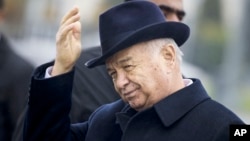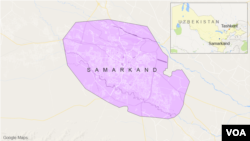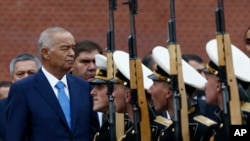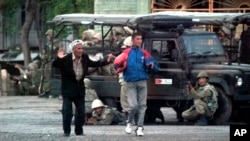Islam Karimov was born in Samarkand, the ancient Silk Road city in eastern Uzbekistan, in 1938, at the height of Soviet dictator Josef Stalin’s purges.
According to various unofficial biographical accounts, Karimov’s father was jailed two years before his birth and was not the president's biological parent; in 1941, after his father was released from prison, Karimov’s parents placed the young boy in an orphanage. They reportedly brought him home the following year, but then returned him to the orphanage in 1945.
According to his official biography, Islam Karimov graduated from a polytechnic institute in 1960 with an engineering degree and then worked at various industrial concerns in the then-Soviet republic. He later worked for the Uzbek Soviet Socialist Republic’s Gosplan — or state planning committee — received an economics degree and, in 1983, was made the Uzbek Soviet republic’s finance minister.
In 1989, he was appointed first secretary of the central committee of the Uzbek branch of the Soviet Communist Party. The following year, Karimov was elected Uzbekistan’s president by the republic’s Soviet-era parliament. While Karimov “convinced” a majority of Uzbekistan’s electorate to vote in favor of the republic remaining part of the Soviet Union in a March 1991 referendum, just months later, in August 1991, he declared Uzbekistan’s independence following the Soviet Union’s failed hardline coup. He was elected independent Uzbekistan’s first president in December of that year.
Several opposition parties were allowed to participate in the December 1991 presidential election, which Karimov won with 86 percent of the vote; international observers, however, cast doubts on its legitimacy, with Human Rights Watch (HRW) calling it “seriously marred.” Western observers similarly dismissed subsequent ballots in Uzbekistan, including a 1996 referendum to extend Karimov’s term in office. He ran again for president in December 2007 despite a constitutional ban on serving more than two terms, and won still another term in 2015, with 90 percent of the vote.
‘Appalling human rights record’
All the former Soviet states of Central Asia remained under authoritarian rule after the Soviet Union dissolved in December 1991; Karimov’s regime in Uzbekistan was one of the region’s most repressive.
In its most recent annual report, HRW said Uzbekistan “maintained its appalling human rights record in 2015.”
“Thousands of people are imprisoned on politically motivated charges, torture is endemic, and authorities regularly harass human rights activists, opposition members, and journalists,” the US-based humanitarian group wrote. “Muslims and Christians who practice their religion outside strict state controls are persecuted. Authorities force millions of adults to harvest cotton every fall under harsh conditions, netting enormous profits for the government.”
In 2002, two alleged members of the Islamist group Hizb ut-Tahrir were reportedly tortured to death in an Uzbek prison. According to a U.S. State Department report, their torture resulted in “in extensive bruises and burns, the latter reportedly caused by immersion in boiling water.”
Andijan crackdown
Perhaps even more notorious was the incident that took place in the eastern Uzbek city of Andijan in May 2005, when security forces fired into a crowd of protesters, killing hundreds.
Following the September 2001 terrorist attacks in New York and Washington, the United States saw Uzbekistan, which was targeting Islamist groups like Hizb ut-Tahrir and the Islamic Movement of Uzbekistan, as a strategic ally in the fight against al-Qaida and the Taliban in neighboring Afghanistan.
In July 2005, however, after Washington pushed for an international investigation of the Andijan incident, the Uzbek government gave U.S. forces six months to vacate the Karshi-Khanabad Airbase in southeastern Uzbekistan, where some 800 American troops had been stationed since 2001. The U.S. forces left in November 2005.
Deirdre Tynan, who is Central Asia project director for the International Crisis Group and based in Bishkek, Kyrgyzstan, told VOA by e-mail that Karimov would be remembered as “an apparatchik who lucked upon a newly independent, largely rural nation and ran it as a police state while exploiting the labor force.”
“His legacy, as we see it today, is an Uzbekistan associated with torture,” Tynan said. “The full extent of his legacy we can't discern yet. It will depend on what his successor does.”
VOA’s Daniel Schearf in Moscow contributed to this report.









